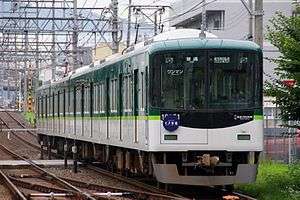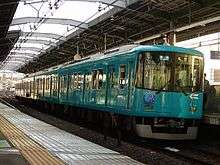Keihan 10000 series
The Keihan 10000 series (京阪10000系, Keihan 10000-kei) is an electric multiple unit (EMU) commuter train type operated by the private railway operator Keihan Electric Railway in Kyoto, Japan, since 2002.[1]
| Keihan 10000 series | |
|---|---|
 A 4-car 10000 series set in revised livery | |
| Manufacturer | Kawasaki Heavy Industries |
| Family name | City commuter |
| Replaced | 1900 series, 2600 series |
| Constructed | 2002-2006 |
| Entered service | 2002 |
| Number built | 24 vehicles (6 sets) |
| Number in service | 24 vehicles (6 sets) |
| Formation | 4/7 cars per trainset |
| Fleet numbers | 10001–10006 |
| Operator(s) | Keihan Electric Railway |
| Specifications | |
| Car body construction | Aluminium |
| Car length | 18,700 mm (61 ft 4 in) |
| Width | 2,780 mm (9 ft 1 in) |
| Height | 4,195 mm (13 ft 9.2 in) |
| Doors | 3 pairs per side |
| Maximum speed |
|
| Traction system | Variable frequency (IGBT) |
| Electric system(s) | 1,500 V DC |
| Current collection method | Overhead wire |
| Safety system(s) | Keihan ATS |
| Track gauge | 1,435 mm (4 ft 8 1⁄2 in) |
Design
The 10000 series trains were developed from the earlier 7200 series and 9000 series trains, and have 18,700 mm (61 ft 4 in) long aluminium-body cars each with three pairs of sliding doors per side.[1]
Operations
Since 2007, the 10000 series sets are primarily used on Keihan Katano Line driver-only operation services.[1]
Formations
As of 1 April 2015, the fleet consists of six four-car sets formed as follows, with two motored ("Mc") cars and two non-powered trailer ("T") cars.[2]
4-car sets
| Designation | Mc1 | T1 | T2 | Mc2 |
|---|---|---|---|---|
| Numbering | 1000x | 1050x | 1065x | 1005x |
- "Mc" cars are motored driving cars (with driving cabs).
- "T" cars are unpowered trailer cars.
- The Mc cars each have one scissors-type pantograph.[2]
7-car trainsets
Set 10001, reformed as a seven-car set in 2016, is formed as follows.[3]
| Numbering | 10001 | 10501 | 10701 | 10101 | 10751 | 10551 | 10051 |
|---|
Car 10701 was renumbered from 9000 series car 9601, car 10101 was renumbered from former 7200 series car 7301, and 10751 was renumbered from former 9000 series car 9602.[3]
Interior
 Interior view in January 2017
Interior view in January 2017 A cab interior view in January 2017
A cab interior view in January 2017
History

A total of six four-car sets were built, with three sets built in 2002 and three in 2006.[1] From 2009, the fleet was repainted into the new Keihan commuter train livery of dark green and white, with the entire fleet treated by 2010.[1]
In February 2015, set 10001 was reformed as a seven-car set by adding two former 9000 series cars (9601 and 9602 from sets 9001 and 9002 respectively) and a former 7200 series car (7301 of set 7201) made surplus when former eight-car sets were reduced to seven cars in 2015.[3]
References
- 私鉄車両年鑑 2013: 大手15社営業用車両完全網羅 私鉄車両年鑑2013 [Japan Private Railways Annual 2013] (in Japanese). Tokyo, Japan: Ikaros Publications Ltd. 20 March 2013. p. 83. ISBN 978-4-86320-693-9.
- 私鉄車両編成表 私鉄車両編成表 2015 [Private Railway Rolling Stock Formations - 2015] (in Japanese). Japan: Kotsu Shimbunsha. 23 July 2015. p. 134. ISBN 978-4-330-58415-7.
- 京阪10000系10001編成が7連化されて試運転 [Keihan 10000 series set 10001 lengthened to seven cars and test-run]. Japan Railfan Magazine Online (in Japanese). Japan: Koyusha Co., Ltd. 18 February 2016. Retrieved 18 February 2016.
External links
| Wikimedia Commons has media related to Keihan 10000 series. |
- Official website (in Japanese)